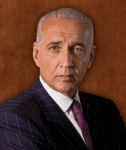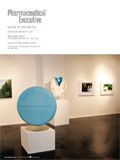Can You Brand Trust?
Lack of trust is preventing pharma from doing what it does better than any other entity on the globe: research and develop new cures and treatments, says Billy Tauzin, president of PhRMA. What to do about it? Twelve top brandmeisters weigh in.
ONE GREAT PROBLEM
By Harry Sweeney
NO, no one can brand trust.
Harry Sweeney

Trust is (or is not) built into every brand-product, corporate, or business sector. A brand isn't just an artist's logo. A brand is a shorthand symbol of trust-and many other factors-constructed over time, which helps assure people of the:
- Trustworthiness of the person or institution that offers the product or service
- Quality of the product or service, itself
Social theorist Niklas Luhmann suggests trust is an evolutionary mechanism created in human beings to cope with high levels of uncertainty and complexity in contempory life by reducing the mental effort necessary to make choices concerning risks.
To explain the role of trust in human transactions, economist Paul Zak and his collaborator, Stephen Knack, studied public trust levels in more than 40 countries, creating the Zak and Knack economic model.
Their startling conclusion? "Differences in trust cause differences in living standards."
Furthermore, the record shows that as trust erodes, the political response is more legislation or regulation-exactly what the drug industry is facing today.
In earlier times, makers of gold coins put their marks (i.e. brands) on the coins, so that unscrupulous shaving of gold from the coins would damage the mark and reveal thieves had been at work.
Conversely, if the mark was clear, the value of the coin could be trusted. As modern economies moved to mass production, "brands" became ubiquitous as symbols of the credibility and trustworthiness of the manufacturer, and of the strength, speed, safety, and/or other attributes of the products being offered.
The importance of trust to the pharmaceutical industry was captured recently by Billy Tauzin, president of PhRMA, who responded to a question about the drug industry's tarnished reputation by saying: "There is one great problem that challenges the ability of America's research-based pharmaceutical companies to continue doing what they do better than any other entity on the globe: research and develop new cures and treatments. In a word, it is trust."
From a net positive rating of 60 percent in the 1997 Harris Interactive 20-industry reputation poll, the pharmaceutical industry rapidly declined to a rock-bottom negative 4 percent in 2004. The pollsters concluded it was almost "surely a direct result of the constant drumbeat of unfavorable publicity about their prices. Industry rating rebounded to 25 percent in 2005, as success of the Medicare Part D prescription drug legislation helped to ameliorate the public's anger.
However, as the volume of negative publicity related to drug pricing abated somewhat, the drumbeat continued with a barrage of bad publicity related to alleged drug safety and disclosure issues.
The magnitude of the trust problem is suggested by the results of a 2007 Harris Interactive survey of opinions about the institutions identified as most responsible for drug safety.
While FDA and drug companies are believed by American consumers to be largely responsible for drug safety-60 percent and 53 percent respectively-only 45 percent of people surveyed trust FDA, and for the industry, the numbers were worse (27 percent).
I believe these perceptions are wrong. But in the court of public opinion, "Perception is reality." And, as we all know, what happens in the judicial courts frequently mirrors what happens in those of public opinion.
Earlier this year, a report from PriceWaterhouseCoopers concluded that consumers do not understand the economics of the industry, nor do they understand (or seemingly, care about) the risks and costs involved in drug development-they want lower prices.
Moreover, they believe the anti-industry rhetoric that "the industry has put profits before patients."
These are significant misperceptions to overcome. However, if we are to restore trust in pharmaceutical industry, company, and product "brands," we must overcome them.
Our work is cut out for us.
Harry Sweeney is chairman, CEO of Dorland Global Corporation, a Huntsworth Health Company. He can be reached at harry_sweeney@dorland.com
ONLINE BRANDS
By Peter H. Nalen
BUILDING a brand is like putting together a jigsaw puzzle: Each piece fits into the overall larger picture. Consider then these integral and essential points:
Peter H. Nalen

CONSISTENCY INSPIRES TRUST It also strengthens the brand. Align the brand's online message with offline programs. Beyond the look and feel of the brand, the entire online experience should be consistent with the brand's position, strategy, and personality.
GET SITE VISITORS TO IDENTITY If the brand delivers relief to an elderly population, make sure the Web site is easy for that population to use-employ larger fonts, simple navigation, and easy-to-use tools. If the brand competes against a larger brand, but has a unique benefit for a distinct subset of patients, quickly connect those patients with the information they seek on the Web site by enabling them to "self identify" via an interactive quiz, testimonials, or profiles of brand users.
MAKE SURE THE USER EXPERIENCE IS A GOOD ONE Research shows a majority of people who do not find what they want within two clicks leave a site (and probably don't return). Employ best-in-class intuitive navigation that is intuitive for each of the targets. Segment the home page so visitors can quickly get to the area of the site that is designed for them. Depending on the audience, include interactive tools and/or games. Where appropriate, show rather than tell with video or flash. People are actively seeking information, not passively perusing a publication. Give them what they are asking for.
HAVE A UBIQUITOUS WEB PRESENCE People approach the Internet like an information buffet-by surveying what's available and taking what they like from several places. Therefore, have your brand accurately and consistently represented in a variety of relevant online locations, including commercial sites, like WebMD, and nonprofit association sites. Make sure the brand and its associated content are appropriately positioned. The brand information needs to be relevant for each site on which it resides; make sure it fits in.
TAKE CARE OF THE BOTTOM LINE Measurement milestones must be established before programs are developed and launched. Once established, ensure all programs are developed and measured by an online marketing specialist who is experienced with sophisticated online analytics software, such as those provided by Omniture, and that the person is an expert in understanding what the software can and cannot do.
Make sure analytic tools are built into all elements of the online marketing program-from Web sites to each of the traffic-generating vehicles used, such as banners, e-mails, paid search ads, etc. Marketers should ensure that the metrics, charts, and graphs are reported back in a way that is compelling and provides insight. Very often, the rationale for "next steps" for the online program is not communicated, preventing the evolution of the online effort.
Peter H. Nalen is president and CEO of Compass Healthcare Communications. He can be reached at peter@compasshc.com
NO SHORTCUTS
By Jamie Cobb
Jamie Cobb

WHETHER consciously or subconsciously, for most consumers, trust is a function of a good brand story. And what is a good brand story? It is a compelling, relevant, interrelated promise of insights and attributes that's unique to every brand and written with a specific kind of consumer in mind. It is the story that invites the consumer to have a dialogue with the brand-to join it, to engage with it.
What's the best way for a brand to engage? Successful brands listen. They realize they are not always creating loyalty and trust, but earning it, one experience at a time.
Too often, marketing directors want to build trust (or trustworthiness) into the short list of personality traits for their brands. While that sounds like a great shortcut, it's a formula for an unrealistic dialogue. Imagine introducing yourself at a meeting or a party as a "reliable and likeable guy." Most people will save judgment until they have had their own experience with you.
Even with all the brand "dos and don'ts" that exist, there's a simple way to look at the relationship a brand should have with one of its stakeholders. After all, what we look for in brands is a little bit of ourselves. Maybe a slight reflection of the self we want others to see. And admire.
If that's the case, then the answer of how strong brands lead to trust is quite simple. Who can you trust if you can't trust yourself?
Jamie Cobb is executive creative director of MicroMass Communications. He can be reached at jamie.cobb@micromass.com
RISK MARKETING
By Michael Guarini
Michael Guarini

TRUST implies the presence-and acceptance-of a certain amount of risk. It plays a big part in all pharmaceutical marketing, whether explicitly addressed or not.
However, there are certain situations where brand trust plays a bigger role than usual. These include:
- When the consequences of brand failure are high (doctors hate to change what's working, even in the face of improved options).
- When the nature of the problem is extremely personal and involves self-image (men with erectile dysfunction have been very loyal to Viagra).
- In crowded categories with little performance differentiation (doctors recommend glucose meters based on their trust in the company's after-market support programs).
- When market leaders and first-in-category brands are still an option (doctors have been very loyal to Fosomax, the first bisphosphonate for osteoporosis, despite patient preference for newer, once-monthly products).
- Where physician experience is shallow, such as with new product launches or infrequently seen conditions (low prescribers in every category typically commit just one brand to memory and use it almost exclusively).
Like any other valued brand attribute, trust needs to be incorporated into the fabric of the brand, and that starts with creative messaging. Witness the creative brief: Agencies can easily restate the "reason to believe" section as "reason to trust."
Beyond creative messaging, the other critical area where I believe trust is built every day is the sales force. Like other categories where products or services involve an ongoing relationship with a sales representative (e.g. insurance, automotive, real estate, financial services), to the customer, the pharma representative is the brand.
In pharmaceutical selling, trust is built over time and depends on training, professionalism, and dedication to doctor and patient needs-not just brand objectives. You can see the result of this in surveys of physicians, who show clear preferences when it comes to company sales forces. They see the clinical data package, willingness of reps to present brand benefits with "fair balance," and even samples as brand components that help build and maintain trust.
Michael Guarini is regional president, North America of Ogilvy Healthworld. He can be reached at mike.guarini@ogilvyhealthworld.com
BE TRANSPARENT
By Rebecca Robins
Rebecca Robins

AT a time when consumer confidence has been shaken by product withdrawals and the media is spotlighting every ill of the industry (while backlighting every good), companies need to engage with the true role and meaning of a brand as never before.
A brand is the ultimate mark of trust. It is the Kitemark of quality, the emblem of efficacy, and the reassurance of reliability that is afforded by one product over another, or indeed, by a brand over a generic. Recently, the findings of a study presented at the European Society of Cardiology, in Vienna, highlighted the stark reality of switching patients from a branded statin to a generic: Switching was shown to be associated with a 3o percent increase in the risk of heart attack or stroke. The results suggest the added reliability and strength of branded formulations-and keeping those brands alive, even in the face of generic competition.
The principle-and practice-of trust applies to product and corporate brands alike and, of course, the relationship between the two. For too long, pharma companies have demonstrated a reluctance to assert their identity, driven for the most part by a self-protective separation of "church" from "state." In other words, there has been a tendency to maintain a degree of distance between the corporate and product brand to protect companies from, in the worst case, product withdrawal and possibly unforeseen side effects. However, pharma companies need to move toward the clear and distinctive assertion of who they are and what they-and their brands-stand for. What's more, this communication needs to disseminate from the top down. Transparency of communication is key to the foundations of any mark of trust.
Brands have become more visible than ever before. The brands that will succeed will be those that take ownership of that visibility, through defining clear and meaningful values, communicating them consistently with all audiences, and delivering on them at every touchpoint.
The tenets of trust already have been established. It is the exchange of trust that the industry is now grappling with-and where the work remains undone.
Rebecca Robins is global marketing director, Interbrand Wood Healthcare and head of Interbrand Wood Healthcare in London. She can be contacted at rrobins@interbrandwood.com
BRAND BASICS
By James L. Dettore and Scott Piergrossi
James L. Dettore

ACCEPT this premise: Marketers of pharmaceutical brands begin at a trust disadvantage, with the public instilling the same amount of faith in Big Pharma as they do in the tobacco industry. In the face of such opposition, what should pharma execs do? Remain clear-headed and focus on branding basics. Keep in mind:
- Trust can be earned, even in the pharmaceutical industry
- Trust is established over time through positive customer experience
- Trust is established when a product delivers on its brand promise-the big idea behind your brand, which should be meaningful and tangible to customers and, in turn, promote a sense of integrity
- While trust may be earned, it can also be lost.
Consistency underlies all these themes. In particular, pharma marketers must ensure that they:
- provide customers with a positive experience every time
- instill a sense of reliability
- stay true to the brand promise
- remain vigilant in reinforcing the brand identity by being proactive
- promote a sense of caring by way of emotional elements to make the brand memorable and to solidify trust.
Scott Piergrossi

No short-term, trust-gaining solution exists. However, put the industry in context: A few brands with unanticipated adverse events, in a marketplace with tens of thousands of effective products, ought not overshadow an industry's potential to dramatically improve life.
James L. Dettore is chairman and chief executive officer of Brand Institute and Scott Piergrossi is director, creative development of Brand Institute. They can be reached, respectively, at jdettore@brandinstitute.com spiergrossi@brandinstitute.com
TRIED AND TRUE METHODS
By Al Topin
Al Topin

CUSTOMERS today are more skeptical and more educated than their predecessors. Enabled and empowered by the Web, they conduct their own research and use the Internet to seek the opinions of others. Nonetheless, the basic principles of building brands that worked a century ago still work today.
So, what are these time-honored ways to build lasting and meaningful brands? And what does this mean to our business as pharmaceutical marketers?
PROMISE
The relationship between the brand and the customer is two-fold. It starts with a promise (whether it's to a physician, his staff, patients, an employee, or others) to:
- deliver an efficacious product
- back it with credible science
- support it with service
- remain consistent-in quality and communications
- do what's right if there is a problem.
If a company can deliver on this brand promise, customers will respond with trust in the product and the company. Even more importantly, by delivering on a promise, we earn our customers' trust.
TRUST
Trust, then, is at the very core of a good brand and is the second part of the brand-building-relationship equation.
Trust is about building solid, positive relationships all along the way. It's about building credibility and consistently delivering quality-whether it's a sales representative talking with a physician, or a CEO meeting with analysts and shareholders.
A patient takes a drug because he or she has faith and trust in his or her physician. The physician prescribes it because he or she has faith and trust in the drug and the company. It's trust that makes the brand much more than a logo.
The concept of branding trust can be done only by companies that have earned it and maintained it over time. To brand a newly launched drug or start-up as "The One to Trust" would be difficult. And what little equity that might be built in a short period of time can be dashed quickly if business objectives, brand promise, and customer experience are inconsistent.
If done well, your target audience will trust your brand to deliver what it has promised and be loyal to it. They will even forgive the brand if there is ever a bad experience. Moments of truth exist in any type of relationship that can make or break trust.
BRAND EXPECTATIONS
Agencies can play a valuable role in helping a company build a brand by understanding the company, the product, and the customer (be it physician, pharmacist, or patient)well enough to put the brand's message and promise into the proper context. They can also help ensure the company communicates a consistent message and clearly manages expectations and perceptions.
Still, at the end of the day, pharma companies must steward their brands by routinely asking such questions as:
- Have we been clear with the physician about the product, and not over-promised the benefit?
- Are we supporting the physician with clear educational materials for his or her patients?
- Are we providing the service, the information, and the necessary access to our company/product?
- If a problem does occur, are we prepared to deal with it transparently?
A trust position is maintained through the brand/company's actions, performance, and experience. As Abraham Lincoln said, "Character is like a tree and reputation like its shadow. The shadow is what we think of it; the tree is the real thing."
Al Topin is president of Topin Associates. He can be reached at atopin@topin.com
HONEST AND NON-HYPERBOLIC
By Bob Mason
Bob Mason

ARGUABLY, trust is always a prime component, if not the prime component, we're trying to establish with our audiences.
Millions of business school students around the globe have had the mantra drilled into their heads, but it bears repeating here: A brand is a promise kept. And, of course, keeping a promise is the foundation of trust.
In today's hypercompetitive marketplace, where there's a "me too" product at every turn, the temptation is simply to overpromise and proverbially "outshout" the competi-tion. (Advertising Age even recently ran an article titled "Don't Convince Us that Your Brand's Better If It Isn't.") It's apparent that this approach to communication just annoys today's smarter-than-ever customer.
My advice? To break through the din-and not just add to it-we need to come up with brand ideas that are more credible, relevant, and "ownable"-the crux of solid positioning. And we need to assume an honest and non-hyperbolic tone in our communications and sales approach.
This takes rigor and strategic planning to build the cogent, credible story around our brands. But, perhaps even more challenging, it also takes an element of restraint to avoid overstating what our brands do and alienating our audience.
Bob Mason is senior vice president, director of brand strategy for Palio Communications. He can be reached at bmason@palio.com
PRESENTING ONESELF
By Forrest King
Forrest King

YES, you can brand to build trust. But in order to do that, a customer must be reasonably certain the company has the customer's best interests in mind.
This type of thinking has companies scurrying to change their institutionalized business practices. Just look at McDonald's, which is actively investing in both com-municating and demonstrating a commitment to their customers' health by offering health-conscious food options. Regardless of the menu choice the customer makes, McDonald's is working to demonstrate its genuine concern both in words and in actions.
In today's environment of rampant mistrust of corporations, companies must increasingly choose to act on behalf of customers and get the word out about their corporate deeds. Customers need to see and hear corporations making choices that put the health and safety of customers first.
On the advertising and promotion end of the branding continuum, this issue translates into an important question: How should a company present itself to build trust? Here are three areas of impact to consider and questions to ask:
- CONTENT When promoting your product, have you provided fair and balanced information for your customers? A brand excessively focused on a one-sided presentation risks compromising credibility and damaging trust.
- TONE How does your brand speak? Authenticity and transparency are essential in developing lasting, recurring relationships with your brand or company.
- CREATIVE Many brands are visually designed to be showy or to stand out by using the brightest and boldest color options possible. Customers may be put off by the hey-look-at-me attitude of many brands.
So, when presenting your company or brand to the world, trust can be achieved by consciously choosing to act with the best interest of your customers as your guide.
Forrest King is managing partner at JUICE Pharma Advertising. He can be reached at fking@juicepharma.com
MAKE ESSENTIAL DRUGS
By Jay Carter
Jay Carter

AMERICANS trust pharma brands. Let's get that out of the way right now.
Valium has been generic most of my professional career in healthcare advertising, and even though pharmacists fill their customers' prescriptions with generic diazepam, people trust the brand. The Ventolin inhaler is a trusted icon, so common that it is used regularly in teen movies to communicate who the nerd is. Likewise, they trust the Purple Pill. And although they may smirk, people trust the Little Blue Pill too.
Americans don't trust pharmaceutical companies. Worse, they don't trust the FDA to protect them from pharmaceutical companies. That's the problem that we as an industry need to worry about.
The FDA's imprimatur used to lend a brand that gave drugs the perception of efficacy and safety. That's less true today, which means that marketers must work harder to communicate safety.
BRANDING BLOCKBUSTERS
For a select few brands that have the broad appeal to be blockbusters, branding is all about creating a persona that accurately yet positively communicates the efficacy and safety of the brand.
It's also essential not to overpromise, to answer questions before they're asked, and always to be approachable. Communication channels like DTC and the Internet make these requisites much more possible today than they were when Valium launched, so marketers now have a big advantage in caring for their mega-brands.
BRANDING NON-BLOCKBUSTERS
For the marketers of non-blockbuster products, branding is about giving the product a personality that is transparent. Marketers are advocates for the brand. We communicate the advantages, and we help healthcare providers and patients understand the potential negatives-not by hiding the negatives, but by spotlighting them clearly and in context. When Johnny Cochran had trouble with the gloves, he didn't shirk, he confronted the issue head on.
Many people talk about the "potential for branding to save pharmaceutical companies from generics."
Rishad Tobaccowala of Publicus was recently quoted at the OPA Global Forum in London as saying, "I don't want a relationship with Tylenol. I just want my headache to go away."
Personally, I have a relationship with Tylenol-a positive one-but I buy generic acetaminophen because it makes my headache go away, and I'm not willing to pay the premium for Tylenol. My connection with the brand is not so profound that I wish to shell out the extra $2.98 for a bottle.
BRANDING QUALITY
I think it is the industry's job to continue to innovate to find solutions for unmet healthcare needs. PhRMA's Web site says its members are "devoted to inventing medicines that allow patients to live longer, healthier, and more productive lives." Doing that will command a price premium, because Americans are willing to pay more for better products.
Branding's job in the process is to increase the velocity of the sales curve so that profits can continue to enable our industry to meet the healthcare needs of humanity in the future. I don't want to live in a world where there isn't hope for a cure for cancer, for diabetes, or for MS. And it is our industry that gives the world that hope.
Jay Carter is senior vice president, director of client services at AbelsonTaylor. He can be reached at jcarter@abelsontaylor.com
EMPLOYING EDUCATION
By Carleen Kelly
Carleen Kelly

BUILDING a brand is becoming more important as companies try to differentiate themselves in an increasingly global and competitive marketplace.
Brand trust communicates expectations of how a brand performs and its reliability. Trust has to be earned over time and brand trust can be gained with time, based upon how the brand performs.
Lipitor, Prozac, and Nexium may provide brand trust for not only their brands and/or their manufacturers, but also for the industry. When safety issues with Celebrex, Vioxx, and Crestor emerged, however, the industry itself lost brand trust. With growing consumer skepticism, developing brand trust is becoming more important, yet is becoming more difficult.
For example, if the industry were to develop a huge educational program on the importance of taking your hypertensive medications, the current cynical sentiment likely would be that the industry was providing this education because it was interested in selling more drugs-not because it was concerned with preventing strokes and heart attacks.
Even when we provide fair balance at the end of DTC ads, consumers are often confused with the long list of side effects. They wonder what it means to them. Why should they see their physician about the product?
We have an opportunity to reverse this trend by using our extensive knowledge and resources to "appropriately" educate. We need the right messages. We also need to ensure the messages come from credible sources, sources consumers currently trust.
This will provide a halo for building trusted brands, including the pharmaceutical industry's brand.
Carleen Kelly is president of Surge Worldwide Healthcare Communications. She can be reached at carleen_kelly@surgehealthcare.com
The Misinformation Maze: Navigating Public Health in the Digital Age
March 11th 2025Jennifer Butler, chief commercial officer of Pleio, discusses misinformation's threat to public health, where patients are turning for trustworthy health information, the industry's pivot to peer-to-patient strategies to educate patients, and more.
Navigating Distrust: Pharma in the Age of Social Media
February 18th 2025Ian Baer, Founder and CEO of Sooth, discusses how the growing distrust in social media will impact industry marketing strategies and the relationships between pharmaceutical companies and the patients they aim to serve. He also explains dark social, how to combat misinformation, closing the trust gap, and more.
